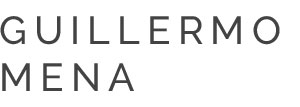You don’t need to spend a lot of time in the woods to experience the impression always a little distressed
that we “sink” in a world without limit. Soon, if you don’t know where you are going,
you don’t know where you are either.
Gaston Bacherald, The Poetics of Space
The effect of light filtering through the foliage was the obsession of not a few painters: Auguste Renoir scattered his brief yellow-white spots on the clothing of modest lovers and also in the bustle of a summer dance, Juan José Cambre gave us synthesized foliage, silhouettes dark against a light color that was no longer yellow, but violent green, bright pink, plastic orange. Josefina Robirosa impregnated its thick bushes of vegetation with a light that emanates from the wooded heart itself. The forest ensures the interruption of the gaze, the search for the interstices free of trunk and foliage, the clear eyes that open in the fragrant gloom that the forest provides.
Guillermo Mena returns to the forest but not to paint it but to film it. Know the site: it belongs to his childhood. The displacement then is to retrace the steps of who he was in other times. Art has its resources to make images past: Mena records his walk in color and converts to black and white. It is not just the resource of “going back past”, but there is someone who draws here: Guillermo Mena carbonizes the filmic images. And he creates with coal (which he himself makes) images of impending catastrophes: storms, flares, floods, an ascending energy that engenders in the dark the promise of light – there too, on the velvety and rough surfaces of the coal squeezed against the wall , white eyes and interstices are opened. Mena superimposes the filmic records of the forest and accentuates the feeling of strangeness; light-burned areas, shimmering glitters from the scene, shadow pits, ghost trees; the stage trembles and recedes as we try to enter it. The forest is a memory of the disappearances and is also a quarry from which the material (charred wood) will be extracted for the appearance of the drawing. But the manipulations of the first approaches to the landscape do not stop there: the artist extracts frames from the video – many – as if it were possible to sequentially reconstruct an already hindered movement, fossilizes the route in the photograph and the postcards multiply solitary.
Mena’s work has two ways of moving: prowling and direct physical action. The first movement is made up of a groping forward that shelters hesitation and regrets, a reasoning that bites its tail in the constant questioning of what has been done and what is to come, a transit of gray and porous areas like banks of mist. The second is the passage to action, the decision that dispels mists and involves a quantity of force applied to a material that sacrifices itself to the vestige and accounts for its fading. The forest offers the walker willing to lose the path a serpentine and cyclical walk. The forest plot intercepts flight and encourages permanence.
A verse by Jules Supervielle said that we are “delicate inhabitants of the forests of ourselves”. Guillermo Mena offers us a melancholic and stubborn look like the murmurs of hidden things; a hiker immersed in a gallery of soot-veiled mirrors.
Verónica Gómez
Buenos Aires, November de 2018
www.veronica-gomez.com.ar
